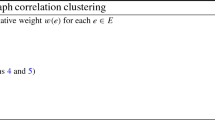Abstract
We consider the following clustering problem: we have a complete graph on n vertices (items), where each edge (u, v) is labeled either + or − depending on whether u and v have been deemed to be similar or different. The goal is to produce a partition of the vertices (a clustering) that agrees as much as possible with the edge labels. That is, we want a clustering that maximizes the number of + edges within clusters, plus the number of − edges between clusters (equivalently, minimizes the number of disagreements: the number of − edges inside clusters plus the number of + edges between clusters). This formulation is motivated from a document clustering problem in which one has a pairwise similarity function f learned from past data, and the goal is to partition the current set of documents in a way that correlates with f as much as possible; it can also be viewed as a kind of “agnostic learning” problem.
An interesting feature of this clustering formulation is that one does not need to specify the number of clusters k as a separate parameter, as in measures such as k-median or min-sum or min-max clustering. Instead, in our formulation, the optimal number of clusters could be any value between 1 and n, depending on the edge labels. We look at approximation algorithms for both minimizing disagreements and for maximizing agreements. For minimizing disagreements, we give a constant factor approximation. For maximizing agreements we give a PTAS, building on ideas of Goldreich, Goldwasser, and Ron (1998) and de la Veg (1996). We also show how to extend some of these results to graphs with edge labels in [−1, +1], and give some results for the case of random noise.
Article PDF
Similar content being viewed by others
Explore related subjects
Discover the latest articles, news and stories from top researchers in related subjects.Avoid common mistakes on your manuscript.
References
Alon, N., Fischer, E., Krivelevich, M., & Szegedy, M. (2000). Efficient testing of large graphs. Combinatorica, 20:4, 451–476.
Alon, N., & Spencer, J. H. (1992). The probabilistic method. John Wiley and Sons.
Arora, S., Frieze, A., & Kaplan, H. (2002). A new rounding procedure for the assignment problem with applications to dense graph arrangements. Mathematical Programming, 92:1, 1–36.
Arora, S., Karger, D., & Karpinski, M. (1999). Polynomial time approximation schemes for dense instances of NP-Hard problems. JCSS, 58:1, 193–210.
Ben-David, S., Long, P. M., & Mansour, Y. (2001). Agnostic boosting. In Proceedings of the 2001 Conference on Computational Learning Theory (pp. 507–516).
Blum, A., & Karger, D. (1997). An Õ(n 3/14)-coloring algorithm for 3-colorable graphs. IPL: Information Processing Letters, 61.
Charikar, M., & Guha, S. (1999). Improved combinatorial algorithms for the facility location and k-median problems. In Proceedings of the 40th Annual Symposium on Foundations of Computer Science.
Charikar, M., Guruswami, V., & Wirth, A. (2003). Clustering with qualitative information. In Proceedings of the 44th Annual Symposium on Foundations of Computer Science (pp. 524–533).
Cohen, W., & McCallum, A. (2001). Personal communication.
Cohen, W., & Richman, J. (2001). Learning to match and cluster entity names. In ACM SIGIR'01 Workshop on Mathematical/Formal Methods in IR.
Cohen, W., & Richman, J. (2002). Learning to match and cluster large high-dimensional data sets for data integration. In Eighth ACM SIGKDD International Conference on Knowledge Discovery and Data Mining (KDD).
Condon, A., & Karp, R. (1999). Algorithms for graph partitioning on the planted partition model. Random Structures and Algorithms, 18:2, 116–140.
de la Vega, F. (1996). MAX-CUT has a randomized approximation scheme in dense graphs. Random Structures and Algorithms, 8:3, 187–198.
Demaine, E., & Immorlica, N. (2003). Correlation clustering with partial information. In Proceedings of APPROX.
Emanuel, D., & Fiat, A. (2003). Correlation clustering—Minimizing disagreements on arbitrary weighted graphs. In Proceedings of ESA.
Garey, M., & Johnson, D. (2000). Computers and intractability: A guide to the theory of NP-completeness. W. H. Freeman and Company.
Goldreich, O., Goldwasser, S., & Ron, D. (1998). Property testing and its connection to learning and approximation. JACM, 45:4, 653–750.
Hochbaum, D., & Shmoys, D. (1986). A unified approach to approximation algorithms for bottleneck problems. JACM, 33, 533–550.
Jain, K., & Vazirani, V. (2001). Approximation algorithms for metric facility location and k-Median problems using the primal-dual schema and Lagrangian relaxation. JACM, 48:2, 274–296.
Kearns, M. (1998). Efficient noise-tolerant learning from statistical queries. JACM, 45:6, 983–1006.
Kearns, M. J., Schapire, R. E., & Sellie, L. M. (1994). Toward efficient agnostic learning. Machine Learning, 17:2/3, 115–142.
McSherry, F. (2001). Spectral partitioning of random graphs. In Proceedings of the 42th Annual Symposium on Foundations of Computer Science (pp. 529–537).
Parnas, M., & Ron, D. (2002). Testing the diameter of graphs. Random Structures and Algorithms, 20:2, 165–183.
Schulman, L. (2000). Clustering for edge-cost minimization. In Proceedings of the 32nd Annual ACM Symposium on Theory of Computing (pp. 547–555).
Shamir, R., & Tsur, D. (2002). Improved algorithms for the random cluster graph model. In Proceedings of the Scandinavian Workshop on Algorithmic Theory (pp. 230–239).
Swamy, C. (2004). Correlation clustering: Maximizing agreements via semidefinite programming. In Proceedings of the Symposium on Discrete Algorithms.
Author information
Authors and Affiliations
Rights and permissions
About this article
Cite this article
Bansal, N., Blum, A. & Chawla, S. Correlation Clustering. Machine Learning 56, 89–113 (2004). https://doi.org/10.1023/B:MACH.0000033116.57574.95
Issue Date:
DOI: https://doi.org/10.1023/B:MACH.0000033116.57574.95




